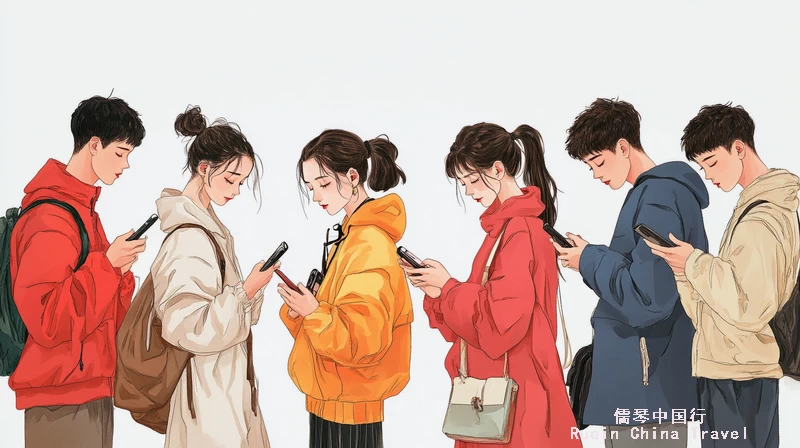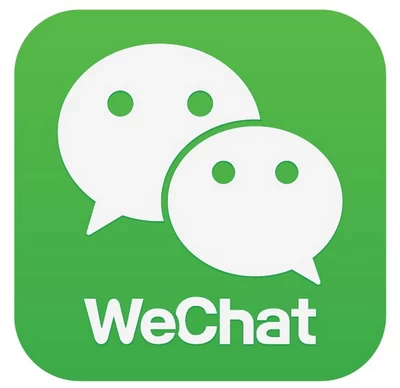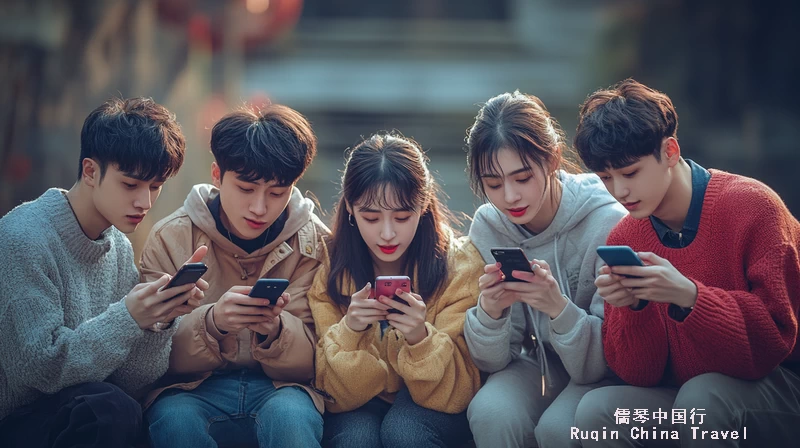Social media has transformed daily life across the world, and China is no exception. However, the social media landscape in China is unique, with platforms that cater specifically to the Chinese market. For travelers visiting China, understanding the influence of social media in China—especially platforms like WeChat, Weibo, and Douyin (TikTok)—can offer valuable insights into Chinese culture and daily interactions. This guide will provide an overview of these platforms and how they impact social trends, communication, and culture in China.
The Social Media Landscape in China
The social media landscape in China is distinct from what most foreign tourists are used to. Due to government restrictions, popular Western platforms like Facebook, Twitter, and Instagram are blocked in China. Instead, Chinese apps such as WeChat, Weibo, and Douyin dominate, creating a vibrant digital ecosystem. Each of these platforms serves different functions, from social networking to news sharing and video content.

Unlike many Western apps, Chinese social media platforms are often multifunctional. For instance, WeChat combines messaging, payments, and shopping, making it essential in everyday life. Because of this, social media in China has evolved into a major part of the economy, influencing not only communication but also consumer behavior, business, and government interactions.
WeChat: China’s Super App

WeChat, developed by Tencent, is China’s most popular social media platform, often referred to as a “super app.” WeChat goes beyond messaging; it’s a hub for a wide range of services. Chinese users rely on WeChat for messaging, news, mobile payments, shopping, and even booking doctor appointments. As a tourist, understanding WeChat’s influence is essential because it is integrated into so many aspects of daily life.
Using WeChat in China as a tourist is straightforward. First, download the app and create an account. WeChat offers an English interface, which makes it accessible to non-Chinese speakers. However, linking WeChat to a Chinese bank account or a payment card will allow you to access its full features, including WeChat Pay, which is widely accepted throughout China. Additionally, many businesses, from restaurants to taxis, prefer mobile payments through WeChat.
Through WeChat, tourists can also join group chats, follow official accounts, and keep up with current trends. Many cities have WeChat groups for expats and tourists, where you can find travel tips, recommendations, and event information. Given WeChat’s many uses, it is much more than a messaging app—it’s a social and economic tool that reflects the influence of social media in China on everyday activities.
Weibo: China’s Version of Twitter

Weibo, created by Sina, functions similarly to Twitter, but with features specific to the Chinese audience. Weibo is a microblogging platform where users post short messages, images, and videos. It is also a powerful platform for news and public opinion, as it allows real-time updates on events, trends, and social issues.
Weibo is popular for celebrity updates, news, and social discussions. Many foreign and Chinese celebrities, brands, and influencers use Weibo to engage with fans, promote products, and share content. This makes Weibo a valuable resource for tourists looking to stay updated on Chinese trends, popular destinations, and cultural events. Through Weibo, travelers can see the latest trends and gain insights into Chinese opinions on current affairs.
Using Weibo in China as a foreigner is fairly simple. The app has an English interface, although much of the content is in Chinese. Many posts on Weibo go viral, drawing attention from millions. For travelers interested in Chinese pop culture or news, Weibo provides a window into the broader influence of social media in China. Additionally, Weibo is also a tool for learning about local news and events, allowing tourists to experience China more like a local.
Douyin: China’s TikTok

Douyin, known internationally as TikTok, is China’s most popular short-video platform. Owned by ByteDance, Douyin became famous for its entertaining short videos, viral challenges, and creative content. Although TikTok is popular worldwide, Douyin is specifically tailored to the Chinese market, with unique features and content.
Douyin vs TikTok in China reveals some interesting differences. While both apps share similar formats, Douyin has features designed to cater to Chinese users, including in-app shopping, location-based recommendations, and local trends. For example, you might see a video of a local restaurant with an option to book a table directly within the app. This feature allows businesses to engage directly with users, showcasing the influence of social media in China on commerce and local tourism.
Douyin is a great tool for tourists, too. By browsing local content, you can discover hidden gems, popular attractions, and local events. Many travel influencers post destination reviews, giving tourists an idea of where to visit, eat, and stay. Douyin is also ideal for learning about Chinese pop culture, fashion trends, and even language tips.
The Cultural Impact of Social Media in China
The influence of social media in China goes beyond entertainment—it affects cultural norms, business trends, and even government communication. In China, social media platforms are often the primary source of information for the younger generation. Social media allows people to connect, stay informed, and participate in online communities, bridging gaps between urban and rural areas.
Chinese social media platforms also play a vital role in fostering national pride and cultural awareness. For example, platforms like Douyin and Weibo host videos about traditional Chinese culture, such as tea ceremonies, festivals, and calligraphy. Through these apps, users engage with cultural heritage, while tourists gain insights into local traditions and customs.
Social media also influences Chinese consumer culture. Popular social media in China, such as WeChat and Douyin, allows influencers and brands to directly reach their audience. With one click, users can purchase products they see in videos, highlighting the power of social media in Chinese e-commerce. This seamless integration between social media and shopping is unique to China, creating a digital environment where entertainment and commerce are intertwined.
Social Media Censorship and Privacy in China
Social media in China is subject to strict regulations and censorship. The government closely monitors and controls online content to maintain social stability and limit the spread of misinformation. Foreign tourists should be aware that political topics, criticisms of the government, and certain international issues are sensitive topics on Chinese platforms. Content that touches on these subjects is often censored or removed.
However, for tourists using social media to follow local news, discover events, or explore Chinese culture, these regulations may not directly impact the experience. Apps like WeChat and Douyin remain user-friendly, though it’s essential to be cautious and respectful when engaging in discussions.
Additionally, privacy is a topic of concern in Chinese social media. Chinese apps often require personal information, such as phone numbers or payment details, to unlock certain features. Tourists may want to limit the amount of personal information shared, using these platforms for essential functions rather than storing sensitive details.
Using Social Media as a Tourist in China: Tips and Recommendations
For tourists, navigating social media in China can seem overwhelming at first. Here are some practical tips to help you make the most of these platforms:
- Download WeChat Before Arriving: WeChat is widely used for communication, payments, and even transportation. Download the app, set up your account, and link it to a payment method, if possible.
- Follow Local Influencers on Douyin: By following travel influencers and local content creators on Douyin, you can find recommendations for attractions, restaurants, and activities. It’s a helpful tool for discovering popular and off-the-beaten-path spots.
- Use Weibo for News and Trends: Weibo is useful for staying updated on Chinese news, pop culture, and current events. It’s also a great way to learn about trending topics and cultural discussions.
- Be Mindful of Privacy Settings: When using Chinese social media, make sure to review privacy settings and limit the information shared. Many platforms offer custom privacy controls that let you manage who can see your content and personal details.
- Avoid Sensitive Topics: As social media censorship in China is strict, avoid discussing or posting about sensitive political issues. Focus instead on travel, culture, and other lighthearted topics.
Differences Between Chinese Social Media and Western Apps
The main difference between Chinese social media platforms and Western apps lies in functionality. Chinese apps like WeChat are multifunctional, allowing users to access services beyond messaging. WeChat, for example, integrates social networking with payment services, transportation booking, shopping, and more. This all-in-one approach makes it highly convenient and essential for daily life in China.
On the other hand, Western social media apps like Facebook or Instagram are generally limited to specific functions, such as networking or sharing photos. Chinese apps are also more interactive in combining entertainment with commerce. Douyin’s in-app shopping and Weibo’s partnership with brands showcase the seamless integration of social media and e-commerce.
The Influence of Social Media in China on Travel and Tourism
The influence of social media in China extends into travel and tourism, making it easier for travelers to find recommendations, reviews, and travel tips. Many tourist attractions, hotels, and restaurants in China use social media platforms to promote their services. Douyin and WeChat are especially popular for sharing short videos and live streams that showcase attractions and events.
Through these platforms, travelers can see authentic reviews and videos from other users, making it easier to decide which places to visit. Influencers often share travel itineraries, local cuisine recommendations, and cultural insights, giving tourists a more comprehensive view of what to expect.
Social media also helps tourists connect with locals. By joining WeChat groups or following accounts dedicated to expats and tourists, visitors can receive advice on language, cultural etiquette, and must-see destinations. This cultural insight not only enhances the travel experience but also bridges the gap between foreign tourists and Chinese culture.
The influence of social media in China is profound, shaping everything from daily interactions to national consumer trends. Platforms like WeChat, Weibo, and Douyin offer travelers a unique glimpse into Chinese culture and society. By understanding how these platforms work, tourists can engage more deeply with the local community, stay updated on trends, and navigate the country more easily. For foreign visitors, social media in China provides an essential guide to discovering the country’s modern digital landscape and the cultural values that drive it.



